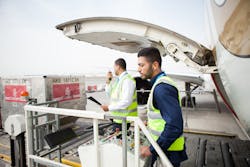Safety Measures That Improve Middle East Operations
In the context of an expanding aviation industry, aircraft ground handling safety is a particularly hot topic in the Middle East and training is key to achieve and maintain safety standards during aircraft ground handling operations.
According to crew resource management (CRM) and human factors (HF) expert Thomas Fakoussa, safe aircraft ground handling training should start with the training of perception, i.e. what and where to look, to hear and to touch.
“The sequence of these sensory inputs is important, as this is when it comes down to experts and their expertise. Experts are such because they have learned what to perceive at which point and in which sequence in order to be safe,” he explains.
Effective Training
In order for aircraft ground handling training requirements and programs to be effectively tailored to the Middle East region, it is first of all important that the trainer understands the group’s basic knowledge and its basic attitude to learning.
“This will decide how to tailor the program according to the group’s motivation. That will shorten the training time and improve the outcome,” says Fakoussa.
At dnata, before employees can undertake any of the key functional training content, they must first complete a theoretical training program and demonstrate they fully understand all safety and risk considerations associated with the role they are being trained for.
“In terms of tailoring programs for the Middle East, there may be some additional or varied local regulatory requirements that will need to be adhered to. But this is also considered in every location the training is delivered,” says Shaun Hannam, head of safety at dnata. “Local, cultural considerations are also factored in to the training solution.”
Safety Culture
Safety culture plays an important role, as it links directly with professional behavior on the ramp. Safety culture is particularly critical as there are some operational challenges given the common industry tendency to get more work done in a shorter time while keeping the safety level high.
“It is pretty self-explanatory that this is not an easy task to achieve. It is quite clear that if the ratio of work done and time limit reach a critical point, safety will have to decline,” says Fakoussa.
It is therefore key to commit efforts to improve the safety culture.
“At dnata, safety culture is part of many cultures, including reporting culture, just culture and learning culture, which are all linked to professional behaviors on the ramp,” says Hannam. “By adopting these cultures, it assists staff in looking after their own personal safety and the safety of the operations. Part of implementing safety culture is to ensure there is a clear understanding of expected behaviors. This includes treating staff just and fairly and ensuring lessons learned are shared among them as part of continuous improvement.
“Some of the challenges in the airport environment is linked to many different cultures and awareness of staff,” he adds. “There are often small and unique cultures within the ramp operation, so it is equally important to ensure the same standards and expectations are communicated to and understood by all staff, contractors and third-party providers.”
Dangerous Goods
Like in many other parts of the world, a safety issue that is quite strongly felt by aircraft ground handling companies in the Middle East is when dangerous goods (DG) are undeclared.
“There are quite strict international and national regulations on the packaging, shipment, storage and segregation of dangerous goods,” points out Hannam. “We invest significant time and resources in training to ensure our staff detect and properly handle and segregate undeclared dangerous goods. In most countries, 100 percent of cargo is screened and technology continues to be enhanced, including the provision of X-ray machines. We expect the number of undeclared dangerous goods to decrease.”
GSE Technology
Ground support equipment (GSE) technology is enhancing the ability of line operatives to work safely on the ramp in the Middle East.
“There is a continued evolution of ground support technology with ever-increasing automation and standardization of equipment to help improve safety on the ramp,” says Hannam. “IATA has also mandated the implementation of aircraft protective systems on ground support equipment to help eliminate damage to aircraft. All our new equipment has been purchased in compliance with this. We are also looking at retrofitting some existing equipment, which can be costly, but provides multiple benefits.
“Airports are also working closely with ground support equipment manufacturers to consider human factors and manual handling issues as part of airport and infrastructure design,” he adds. “The implementation of the new baggage handling system at Dubai World Center (DWC) has recently reduced a lot of the concerns around manual handling, along with more automation and less possibility of human error.”
“Working too heavily for too long in very hot temperatures can be devastating to perception, power and motivation. So, any equipment that can support the ground crews to use less of their energy is a success story,” adds Fakoussa. “On the other side too easy a job will make crews be less aware. So, the correct balance is important.”
Indeed, there are some schools of thought whereby technologically advanced equipment may make the operator become complacent when operating the equipment.
About the Author

Mario Pierobon
Dr. Mario Pierobon provides solutions in the areas of documentation, training and consulting to organizations operating in safety-sensitive industries. He has conducted a doctoral research project investigating aircraft ground handling safety. He may be reached at [email protected].
